Family Labridae: Bera-ka
Labrids are widely recognized as being diurnal (Hobson, 1965, 1974; Collette and Talbot, 1972; Masuda et al., 1980). During the day they swim close to the substrata, usually coral and rocky reefs, where they actively hunt prey, and at night they rest in reef crevices, under the sand, or on soft corals. Most labrids have strong and well developed pharyngeal teeth adapted to crush hard-bodied prey such as gastropods and decapoda (Hintt and Strasburg, 1960; Hobaon, 1974; Masuda et al., 1980).
Anampses caeruleopunctatus Rüppell: Buchi-susuld-bera
FUMT-P 4255.
The major food item of the single specimen (101 mm SL) collected in spring was gammaridean amphipods (percentage of food item: 90%), and the remaining items were harpacticoid copepods (5%), tanaida (5%), and chitons (+).
Guahima (1981) reported that the diet of this species at Kuchierabu Island, Japan, differs with growth: The small specimens (90-150 mm total length (TL)) feed mostly on small crustaceans, such as amphipods, and polychaetcs, whereas the larger specimens (160-270 mm TL) capture mainly decapoda, shells, and polychaetca.
Anampses geographicus Valenciennes: Mushi-bera
FUMT-P 4256; 3 specimens; spring; 77-99 mm SL.
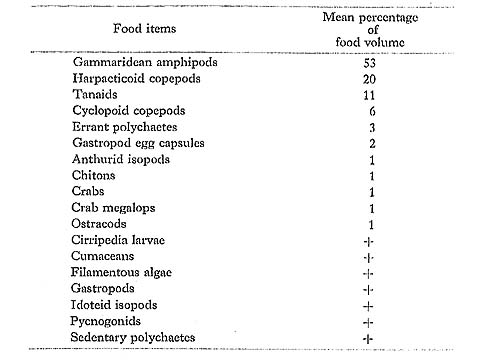
Gammaridean amphipods and copepods that dominated in the diet of A. geographicus at Minatogawa are much the same prey as taken by the same species at Kuchierabu Island, Japan (Gushima, 1981). Hobson (1974) noted that species of the genus Anampses can effectively capture gammaridean amphipods dwelling in the low stubble of algae on the rocks and boulders using their two incisiform, forward-projecting teeth at the front of each jaw. He also suggested that they hunt relatively tiny crustaceans which need not be crushed because they have less developed pharyngeal teeth.
Cheilinus chlorurus (Bloch): Akaten-mochinouo
FUMT-P 4862.
A single specimen (57 mm SL) collected in spring contained ophiuroids (percentage of food volume: 50%), crabs (28%), gastropods (10%), chitons (5%), gammaridean amphipods (5%), and isopods (2%) in the digestive tract.
Hiatt and Strasburg (1960) reported that C. chlorurus in the Marshall Islands subsists primarily on small gastropods inhabiting coral heads or near the rocky bottom.
Cheilinus trilobatus Lacepède: Mitsuba-mochinouo
FUMT-P 4100, 4257; 6 specimens; spring and summer; 87-122 mm SL.
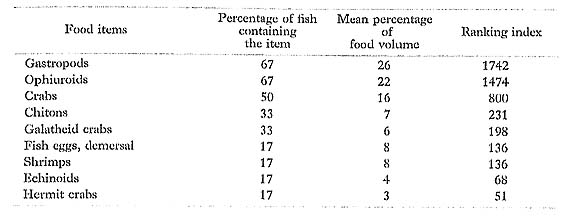
C. trilobatus had taken mostly benthonic invertebrates, especially ophiuroids, gastropods, and deeapods. Hiatt and Strasburg (1960)repoted that this species in the Marshall Islands is a carnivore which feeds primarily on fishes ,crustaceans, and gastropods.
Cheilio inermis (Forsskål): Kamasu-bera
FUMT-P 4101, 4258;10 specimens; sprimg and summer; 117-207 mm SL.
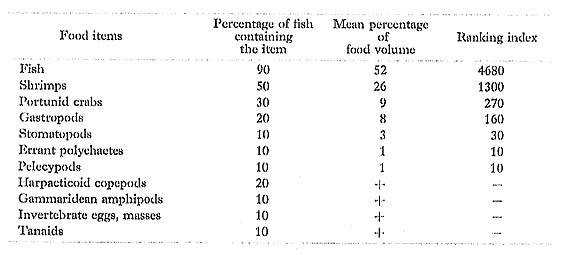
Most of the prey of C. inermis were small fiahes, decapods, and gastropods.
Choerodon anchorago (Bloch): Kusabi-bera FUMT-P 4259.
A single young specimen (80 mm SL) collected in spring contained gastropods (percentage of food volume: 55%), isopods (30%), gammaridean amphipods (15%), and cumaceans (+) in the digestive tract.
Coris aygula Lacepède: Kanmuri-bera
FUMT-P 4102, 4260; 3 specimens; spring and summer; 82-107 mm SL.
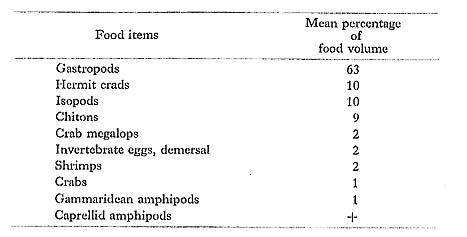
C. aygula contained chiefly crushed gastropods in the digestive tract. Hiatt and Strasburg (1960) found only crushed, sand-dwelling pelecypods and gastropods in the single C. aygula (265 mm SL: as C. angulata) that they examined in the Marshall Islands. Similarly, Gushima (1981) reported that the major prey of the 13 specimens (160-440 mm TL) from Kuchierabu Island were shells (mean percentage of food volume: 83%) and decapods (14%).
Coris variegata (Rüppell): Shichiscn-musume-bera
FUMT-P 4103, 4261; 19 specimens; spring and summer; 66-127 mm SL.
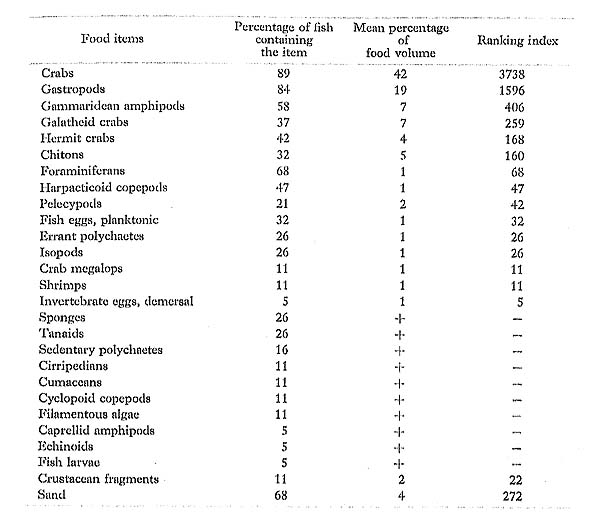
C. variegata had eaten mostly small decapods and gastropods.
Epibulus insidiator Pallas: Gichi-bera
FUMT-P 4180, 4262; 4 specimens; spring and summer; 66-147 mm SL.

E. insidiator had taken only small decapods and fishes. Hiatt and Strasburg (1960) found only alpheid shrimps in the two specimens (125 and 130 mm SL) of E. insidiator that they examined in the Marshall Islands. They commented: "This wrasse habitually feeds in ramose corals by extending its exceedingly protractile snout into the interstices to capture small alpheid shrimps and xanthid crabs living there."
Gomphosus varius Lacepède: Kugi-bera
FUMT-P 4104, 4263; 5 specimens; spring and summer; 74-110 mm SL.

The major item in the diet of G. varius was decapods, especially crabs. Randall (1955) found alpheid shrimps and stomatopods in the two specimens (220 and 230 mm SL: as G. tricolor) from the Gilbert Islands. Hiatt and Strasburg (1960) similarly reported that alpheid shrimps and xanthid crabs constituted the major food of this species in the Marshall Islands. In Hawaii, Hobson found relatively large crustaceans, especially Trapezia sp., in the diet of G. varius, and stated that "this wrasse vigorously wrests its prey from the reef crevices in which they are secreted." On the other hand, Vivien (1973) reported that gastropods are one of the major prey of this species in Madagascar.
Halichoeres marginatus Ruppell: Kanoko-bera
FUMT-P 4106, 4265; 13 specimens; spring and summer; 44-109 mm SL.
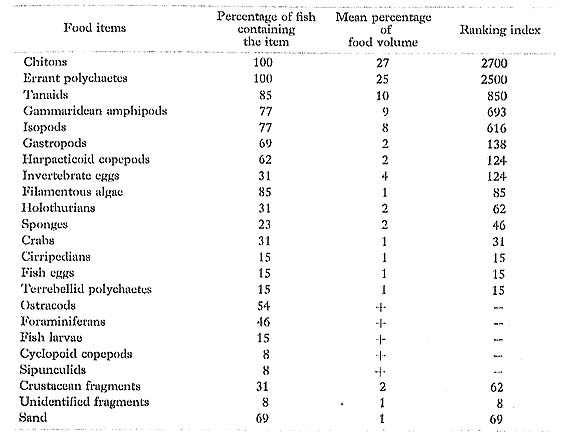
In feeding mostly on benthonic invertebrates, the diet of H. marginatus at Minatogawa was essentially the same as that of the same species in the Marshall Islands (Hiatt and Strasburg, 1960) and Kuchierabu Island, Japan (Gushima, 1981).
Halichoeres melanochir Fowler et Bean: Munaten-bera
FUMT-P 4107, 4266; 8 specimens; spring and summer; 61-114 mm SL.
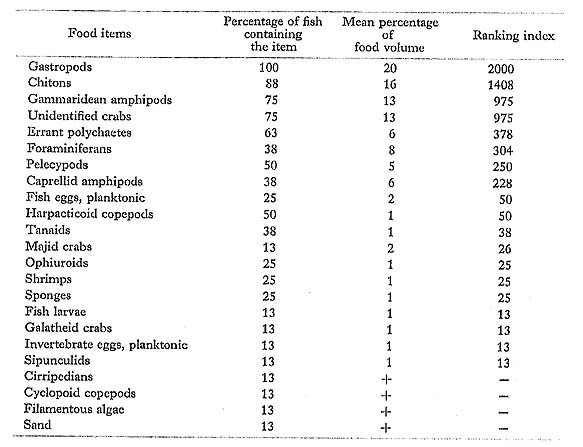
H. melanochir had eaten mostly benthonic invertebrates, especially mollusks.
Halichoeres melanurus Bleeker: Kazari-kyusen
FUMT-P 4105, 4264; 28 specimens; spring and summer; 45-78 mm SL.
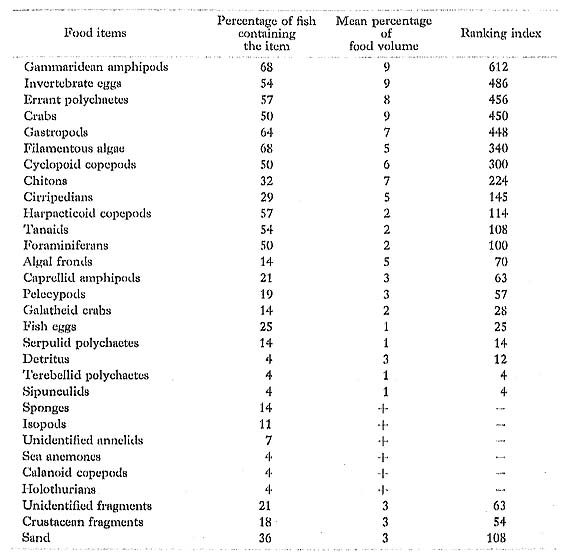
Most of the prey of H. melanurus were small invertebrates, but it also fed on algae. Hiatt and Strasburg (1960) found that the gut of the single specimen of this species (as H. hoeveni) from Arno Atoll, Marshall Islands, was full of only one foraminiferan species (Calcarina sp.), whereas the three from Eniwetok Atoll contained polychaetes, small crustaceans, and algae.
Halichoeres nebulosus (Valenciennes): Inazuma-bera
FUMT-P 4108; 6 specimens; summer; 52-88 mm SL.
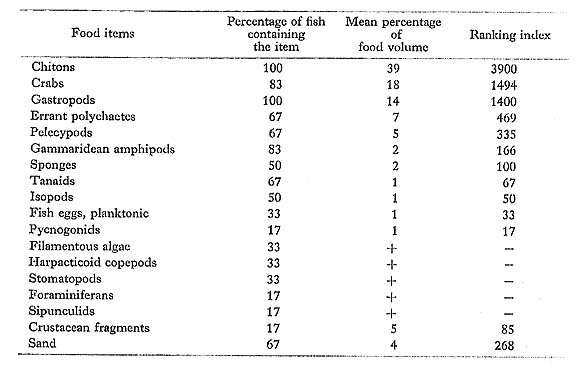
H. nebulosus had fed primarily on benthonic invertebrates, especially mollusks.
Halichoeres trimaculatus (Quoy et Gaimard): Mitsuboshi-kyusen
FUMT-P 4109, 4267; 29 specimens; spring and summer; 54-118 mm SL; 3 empty.
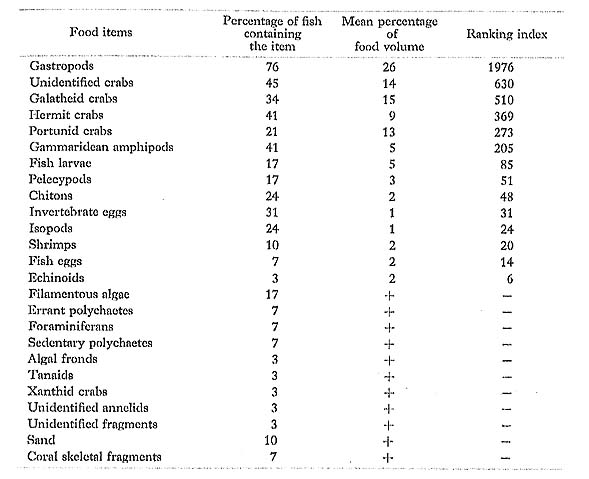
Benthonic decapods and mollusks were the major items in the gut of H. trimaculatus at Minatogawa. Hiatt and Strasburg (1960) also found mostly decapoda, especially hermit crabs, in the diet of this species from the Marshall Islands.
Hemigymnus fasciatus (Bloch): Shima-tarekuchi-bera
FUMT-P 4110, 4268; 5 specimens; spring and summer; 49-82 mm SL.
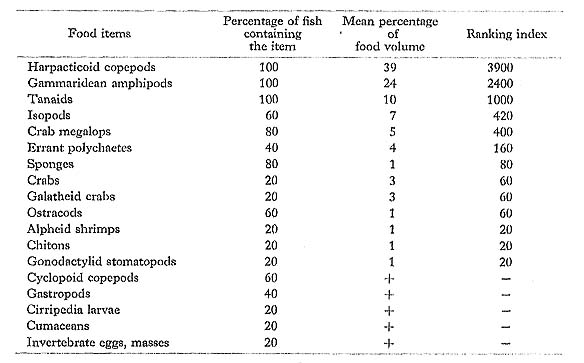
All the specimens of H. fasciatus examined were young and subadult, and their prey were mainly demersal planktonic crustaceans.
Hemigymnus melapterus (Bloch): Tarekuchi-bera
FUMT-P 4111, 4269; 7 small specimens; spring and summer; 39-91 mm SL; 1 empty.
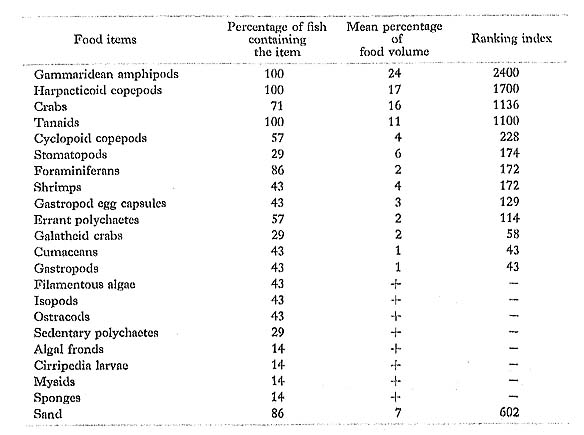
3 large specimens; spring and summer; 108-178 mm SL.
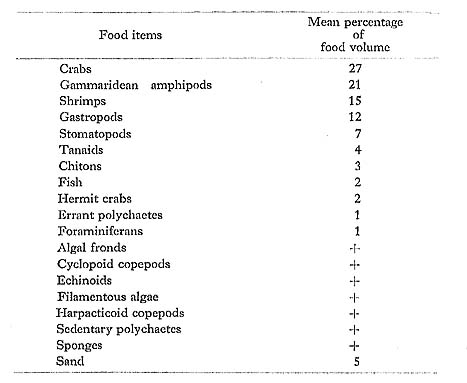
The food habits of H. melapterus differed with growth: Small specimens fed mostly on demersal planktonic crustaceans, whereas larger specimens took relatively larger crustaceans, such as decapods, and gastropods. Hiatt and Strasburg (1960) found mostly crushed gastropods in three larger specimens (120-220 mm SL) of this species from the Marshall Islands.
Labrichthys unilineatus (Guichenot): Kuro-bera
FUMT-P 4112, 4270; 23 specimens; spring and summer; 59-98 mmSL

The major item in the diet of L. unilineatus was scleractinian corals, both polyps and mucus, along with very few skeletal particles. We observed it ordinarily hovering on and near living coral reefs consisting mostly of Acropora and picking the surfaces of living corals. Thus, our data confirm the observation made by Randall and Springer (1973) in Samoa.
Labroides dimidiatus (Valenciennes): Hon-somewake-bera
FUMT-P 4113, 4271; 5 specimens; spring and summer; 58-73 mm SL; 1 empty.

L. dimidiatus is widely recognized as a cleaner labrid which feeds on crustacean ecto- parasites such as gnathiid isopods and caligoid copepods on other fishes (Randall, 1955, 1958; Ehrlich, 1975). We also found numerous fish ectoparasites along with several fish scales in the diet of this species at Minatogawa.
Although Hiatt and Strasburg (1960) found parasitic copepods along with fish scales in L. dimidiatus from the Marshall Islands, they also found midwater plankters, free-living copepods and mysids. Similar results were obtained through our gut content analysis: It had eaten a few planktonic eggs. Despite these planktonic prey, however, its major food and feeding characteristics suggest that it is at least dominantly a predator which picks off ectoparasites from other fishes.
Macropharyngodon meleagris (Valenciennes): Nodoguro-bera
FUMT-P 4114, 4272; 6 specimens; spring and summer; 57-84 mm SL.

M. meleagris had taken mostly foraminiferans and small gastropods, along with large amounts of detritus and sand. Gushima (1981) similarly reported that the major food item of the 12 specimens (90-150 mm TL) from Kuchierabu Island was foraminiferans (mean percentage of food volume: 70%), and the remaining items were shells (19%) and small crustaceans (11%). In contrast to these food data, Hiatt and Strasburg (1960) found only a crushed rock-dwelling gastropod in the single M. meleagris (70mm SL) that they examined in the Marshall Islands.
Pseudocheilinus hexataenia (Bleeker): Nise-mochinouo
FUMT-P 4273; 3 specimens; spring; 50-55 mm SL.
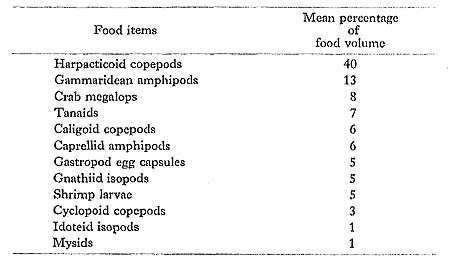
Our food data indicate that P. hextaenia at Minatogawa feeds on crustacean ectopara-sites such as caligoid copepods and gnathiid isopods on other fishes on occasion, although it takes mainly demersal planktonic crustaceans. Hiatt and Strasburg (1960) reported that this species in the Marshall Islands feeds primarily on benthonic fauna, including small crustaceans and foraminiferans, which dwell on rubble and sandy bottoms adjacent to coral patches.
Stethojulis bandanensis (Bleeker): Akaobi-bera
FUMT-P 4115, 4274; 20 specimens; spring and summer; 50-90 mm SL; 1 empty.

Demersal planktonic crustaceans, which predominated in the diet of S, bandanensis at Minatogawa, were also reported to be major prey of the same species in the Marshall Islands (Hiatt and Strasburg, 1960: as S. caxillaris) and Kuchierabu Island, Japan (Gu-shima, 1981).
Stethojulis strigiventer (Bennett): Harasuji-bera
FUMT-P 4116, 4275; 41 specimens; spring and summer; 50-94 mm SL.
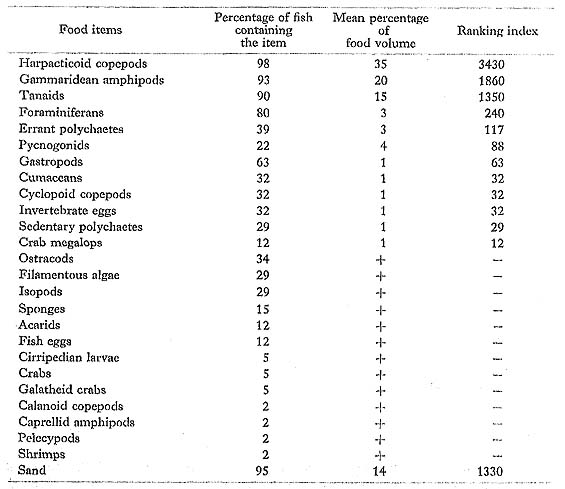
S. strigiventer had taken a variety of small invertebrates, especially demersal plank-tonic crustaceans, as did the same species from Kuchierabu Island examined by Gu-shima (1981).
Stethojulis trilineata (Bloch et Schneider): Oni-bera
FUMT-P 4117, 4276; 9 specimens; spring and summer; 70-92 mm SL.

Like the two congeners at Minatogawa, S. trilineata had eaten various small invertebrates, especially demersal planktonic crustaceans, which are much the same prey taken by the same species at Kuchierabu Island (Gushima, 1981).
Thalassoma amblycephalus (Bleeker): Kogashira-bera
FUMT-P 4277; 2 specimens; spring; 92 and 98 mm SL.
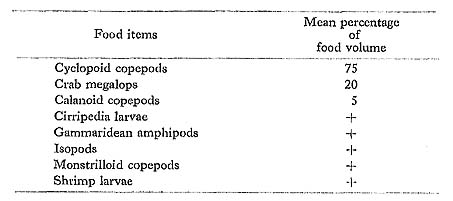
T. amblycephalus had taken mostly small planktonic crustaceans, especially cyclopoid copepods.
Thalassoma cupido (Temminck et Schlegel): Nishiki-bera
FUMT-P 4118; 2 specimens; summer; 61 and 91 mm SL.
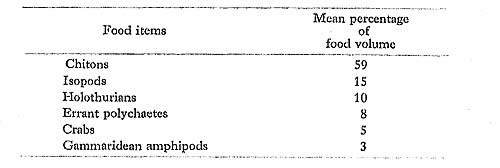
In feeding mainly on benthonic invertebrates, T. cupido at Minatogawa had a diet similar to that of the same species from Kuchierabu Island (Gushima, 1981).
Thalassoma hardwickii (Bennett): Senasuji-bera
FUMT-P 4119, 4278; 9 specimens; spring and summer; 60-96 mm SL.
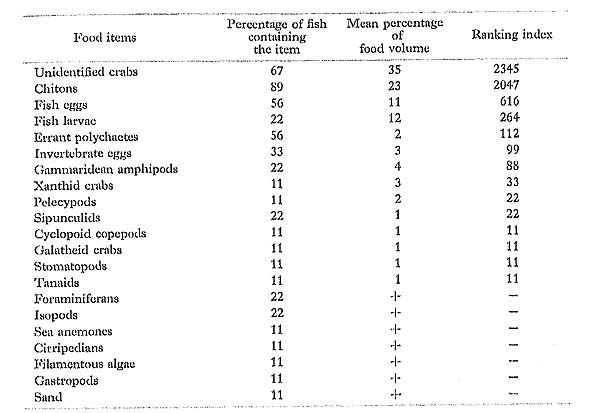
In addition to benthonic invertebrates, T. hardwickii had consumed many fish eggs and larvae. Hiatt and Strasburg (1960) found the diet of this species in the Marshall Is lands to be benthonic and planktonic crustaceans and small fishes. In Madagascar, on the other hand, Vivien (1973) reported that its major food item was gastropods, and the remaining items found in lesser amounts were gammaridean amphipods, fishes, poly chaetes, and craba.
Thalassoma janseni (Bleeker): Yansen-nishiki-bera
FUMT-P 4279.
A single specimen (109 mm SL) collected in spring contained chitons (percentage of food volume: 61%), gastropods (20%), errant polychaetes (15%), crab megalops (2%), and fish scales (2%) in the digestive tract.
Thalassoma lunare (Linnaeus): Otome-bera
FUMT-P 4120, 4280; 15 specimens; spring and summer; 69-152 mm SL; 1 empty.

In addition to various benthonic invertebrates, T. lunare had consumed many fish and gastropod eggs.
Thalassoma lutescens (Lay et Bennett): Yamabuki-bera
FUMT-P 4121, 4281; 3 specimens; spring and summer; 70-153 mm SL.
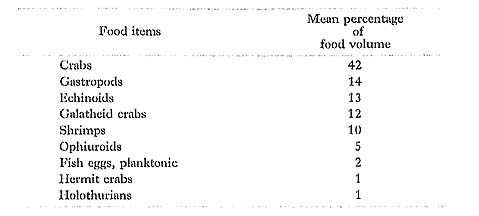
In feeding on benthonic invertebrates, especially decapods, the diet of T. lutescens at Minatogawa was essentially the same as that of the same apecics in the Marshall Islands (Hiatt and Strasburg, 1960). Although Gushima (1981) reported that polychaetes constituted the major food (mean percentage of food volume: 60%) of T. lutescens (80-130 mm TL) at Kuchierabu Island, Japan, we did not find any polychaetes in the diet of this species at Minatogawa.
Thalassoma purpureum (Forsskål): Kinu-bera
FUMT-P 4122; 3 specimens; summer; 67-83 mm SL.
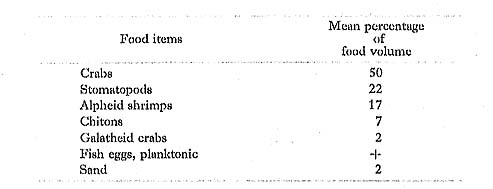
Benthonic crustaceans, especially decapoda, were the major items in the gut of T. purpureum at Minatogawa.



























